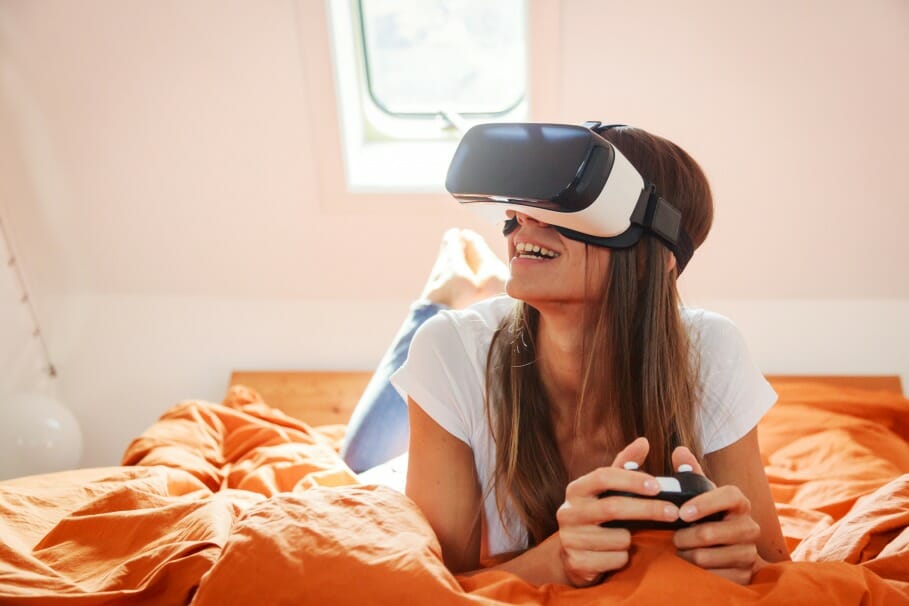When people hear the term "virtual reality," they usually think about what may be its most obvious application: as a tool for gaming fans everywhere. At its core, virtual reality (or VR) involves a computer generated simulation of a 3D image or environment. That image can be interacted with by a user in a seemingly real or physical way thanks to special equipment like a helmet with a screen inside it, with gloves that have sensors in the fingers or, in a lot of situations all of this at the same time.
According to one recent study, the global virtual reality market is expected to hit a staggering $160 billion by as soon as 2023. Worldwide, spending on virtual related content and applications alone is expected to hit an enormous $3.77 billion by the end of 2021. But when you also consider the fact that the total number of VR-centric startups has increased 14% in less than a year, you begin to really get a sense of what is going on here.

To return to the example of gaming, virtual reality can absolutely help transport players to an entirely new world where they can have new experiences, interact with fascinating fictional characters and perform other tasks that they simply can't normally do in the comfort of their own home. For the players themselves, it's a perfect opportunity to increase immersion in their favorite hobby. For game manufacturers, it's an incredible chance to increase engagement by offering the types of experiences that people literally can't get through other means.
But the benefits of virtual reality don't begin and end with gaming. Far from it.
In the world of education, virtual reality hardware can offer students incredible, immersive learning experiences that they just can't get in a traditional classroom. It's a perfect way to inspire not only their own creativity, but their imaginations as well. In marketing, VR can let consumers interact with products before a purchase is made - all without leaving the comfort of their own homes. This allows them to make better and more informed decisions with their hard-earned money, all while letting the marketers themselves create rich and unforgettable experiences.
Even the automotive industry is making excellent use of virtual reality, using it to enable engineers and designers to experiment with the look and build of a car all without the need to spend money on expensive prototypes.
Healthcare, retail, tourism - you name it, there's an industry that can absolutely put virtual reality to good use.
That's why it's so important to pay attention to the types of virtual reality statistics that are being published right now. Not only do they give you an indication of just how far the industry has come in a relatively short amount of time, but they also paint a vivid picture about where this is all headed... and make no mistake, it will branch off in a number of unexpected directions over the course of the next decade and beyond.
The Pandemic Has Acted as an Accelerant for Virtual Reality

One of the most important things to understand about virtual reality in general is that this current feeling of the technology becoming an "overnight success" has actually been a long time coming.
As a concept, VR actually dates all the way back to the 1970s and was used for medical purposes, flight simulation and even military training (in its early forms) all the way up to the 1990s. Consumers first began to interact with VR technology in the 1990s. Sega announced a VR headset for its arcade games and its Mega Drive console as early as 1991, for example. This particular product used LCD screens embedded within a visor, stereo headphones and a series of sensors to let users interact with their gaming content in a whole new way.
The point of this is to say that for decades, virtual reality has been on a trajectory of commercial adoption - it was only a matter of "when." But fascinatingly, that "when" may be coming along a lot sooner than it otherwise would have thanks to the still-ongoing COVID-19 pandemic.
As of 2020, there were about 26 million virtual reality devices owned by private consumers. That's a good number, but it's hardly the stuff that revolutions are made of. During the 1980s and 1990s a total of 16.8 million LaserDisc playerswere sold around the world, and you'd be hard-pressed to find anyone who would argue that this technology stood the test of time.
But despite the fact that there were only about 5.5 million units of VR hardware shipped to consumers in 2020... that number is expected to double to 11 million units by the end of 2021. It will further increase to about 43.5 million units per year by 2025. That eight times increase in just five years is practically unheard of - and the industry may have the pandemic to thank.
Last year, when the Coronavirus sent the entire world into lockdown mode, most people found themselves staying at home indefinitely. They felt cut off from the outside world and need some way, any way, to feel that connection that their day-to-day lives now lacked. In massive numbers, they turned to virtual reality in order to do it - possibly speeding up the "mass adoption" phase of the technology by a number of years or more.
This is a good thing, because as more people buy this hardware and embrace this content, the more next generation virtual reality companies will be willing to experiment. Through experimentation comes innovation, and the next wave of incredible VR products and services arrives far sooner than it otherwise would have.
Virtual Reality Becomes a Major Driver of the Economy

Those who are still skeptical about the long-term impact of virtual reality need only to look at the potential economic impacts of the industry to see just what a big deal this truly is.
Obviously, someone has to be designing, manufacturing and selling all of these VR hardware and software products - which is another reason why paying attention to mass adoption is so important. That's why it's notable that, according to another recent study by a consulting firm, virtual reality in and of itself is capable of adding about $1.83 billion to the world economy by the end of 2030.
Right now, there are less than 500,000 jobs around the world that are directly responsible for virtual reality or related technologies like augmented reality in some way. This, too, will change over the next decade as a massive 23 million jobs are set to involve VR or AR in one way or another.
As people begin to recognize what a major economic contributor virtual reality is poised to be, this too will accelerate innovation and lead to some pretty incredible things across the board.
The Industry Finally Overcomes the Major Obstacles Holding Back Adoption

This journey is important to track because it will also soon intersect with a major breaking point for the industry in general. When you look at emerging technologies, there comes a point where an increased popularity (and increased spending) upon early adopters breeds innovation to the point where many of the obstacles holding others back begin to fall, one-by-one. At that point, the flood gates are open and suddenly what seemed like a niche technology is everywhere.
Additional statistics seem to show that this is absolutely about to happen to virtual reality, too.
According to another recent study, one of the major factors hindering virtual reality adoption is the currently limited availability of content offerings - something that about 27% of people who responded to a survey agreed with. A further 19% indicated that the user experience just wasn't where it needed to be. The cost to consumers was something that 11% said was preventing them from embracing virtual reality - meaning that current hardware and software costs are just too high.
Yet at the same time, about 70% of current VR users say they actually intend to use their devices more over the course of the next year. About 38% of those respondents say that they intend to increase their use "a lot more," while even 32% say that they want to increase their use "a little more." Only 7% seem to say that they're going to decrease the amount they are currently spending on virtual reality hardware and software.
The activity of this core group of existing users will absolutely attract attention for new startups and companies to enter the market, which will certainly drive down hardware and software costs - thus eliminating one of those major barriers of entry before you know it. Once that is accounted for, companies can work on some of these other pain points like improving the user experience and increasing the amount of content offerings available - and at that point, the dominoes begin to fall.
It's something that a lot of industry leaders are paying attention to, as well. When asked about how long it will take virtual reality (and related technologies like augmented reality) to finally hit that true mainstream status, about 37% of leaders say that they expected it to happen within the next two to five years. Roughly a quarter of them said that it would happen within two years. Even a full 15% said that it would happen in less than two years - all things pointing to one "trend" that shows absolutely no signs of slowing down anytime soon.
Virtual Reality Breaks Free of the Smartphone

Finally, no discussion of where virtual reality may be headed over the next decade would be complete without at least referencing the hardware itself.
When people hear the term VR, they usually call to mind images like those described above of people wearing huge, bulky visors with LED or LCD screens contained inside. Even the Oculus, which may very well be the most popular VR headset on the planet right now, matches that description (albeit in a cooler way than those old school visors of the 1990s).
Based on that, it may come as a surprise to learn that in 2016, about 87% of all virtual reality headsets sold across the world were mobile phone-based. This meant that rather than having a dedicated piece of hardware, a user would mount their smartphone into the headset itself and use that as a screen. Google's Daydream View is one prominent example of this, as is the Samsung Gear VR.
Smartphones are great and they're useful for many things... but creating a rich, immersive 3D experience isn't really one of them.
Yet at the same time, one firm based out of London predicted that the global value of the virtual reality hardware and software market - meaning the headsets and the technology that power them - will reach about $10 billion by as soon as 2025, up from just $3.2 billion in 2020. Note that these numbers would likely be even higher had the manufacturing sector not suffered significant setbacks during the early months of the year thanks to the COVID-19 pandemic.
As consumers begin to experience virtual reality in a context that goes beyond their smartphone, they will quickly begin to realize just how massive the implications are. This will once again drive an increased level of spending and adoption, which will further fuel the incredible level of innovation that the industry will experience as a result.
In the End

One of the most important things to understand about virtual reality in general is that it is nothing if not malleable - it can mean a lot of different things to a lot of different people. Because of that, the industry isn't really on "one set path" for success. It's on a few different ones, actually.
Where gamers look at virtual reality as a way to connect with and explore fantastic fictional worlds, workers in the healthcare field are using it to leverage virtual models to better prepare themselves for interacting with real bodies and real patients. Tourism companies are using it as a way to let people "try" their vacation before they actually take it, thus raising awareness and interest in the types of places people might normally overlook. Real estate professionals are using it to let people look around a potential home without ever leaving the confines of their existing one. The list goes on and on.
As statistics like those outlined above go a long way towards proving, it's actually quite difficult to say where the virtual reality industry is headed over the next 10 years - partially because the possibilities really do feel limitless. As spending on next generation VR products and services increases, innovation across the market will do the same. As demand increases - which it will, as VR headsets are predicted to enjoy sales of over 30 million units a year by 2023 - more companies will emerge in an attempt to help fill this very particular need.
But one thing is for certain - virtual reality will soon touch just about every type of business in every industry that you can think of, regardless of its shape or size. VR may have seemed like a passing fad or just another tech trend to be forgotten at one point during the 1990s, but thankfully the technology and hardware have finally caught up with the people who envisioned it in the first place.
When you think about just how far virtual reality has come in a relatively short amount of time, it's truly exciting to think about what those next 10 years do have in store for us all. Because for every innovation that we can predict right now, there will be another five that we won't be able to see coming - and that is a very exciting position to be in, no question about it.


